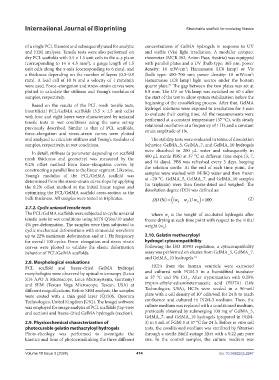Page 482 - IJB-10-3
P. 482
International Journal of Bioprinting Stretchable scaffold for modeling fibrosis
of a single PCL filament and subsequently used for analytic concentrations of GelMA hydrogels in response to UV
and FEM analyses. Tensile tests were also performed on and visible (Vis) light irradiation. A modular compact
dry PCL scaffolds with 3.5 × 1.5 unit cells in the x–y plane rheometer (MCR 302, Anton Paar, Austria) was equipped
(corresponding to 14 × 4.5 mm ), a gauge length of 1.5 with parallel plates and a UV (bulb type: 365 nm; power
2
unit cells along the x-axis (corresponding to 6 mm), and density: 18 mW/cm ; Hamamatsu LC8 lamp) or Vis
2
a thickness depending on the number of layers (0.3–0.9 (bulb type: 400–700 nm; power density: 18 mW/cm ;
2
mm). A load cell of 10 N and a velocity of 1 mm/min Hamamatsu LC8 lamp) light source under the bottom
were used. Force–elongation and stress–strain curves were quartz plate. The gap between the two plates was set at
34
plotted to calculate the stiffness and Young’s modulus of 0.8 mm. The UV or Vis lamp was switched on 60 s after
samples, respectively. the start of the test to allow system stabilization before the
Based on the results of the PCL mesh tensile tests, beginning of the crosslinking process. After that, GelMA
bioartificial PCL/GelMA scaffolds (3.5 × 1.5 unit cells) hydrogel solutions were exposed to irradiation for 3 min
with four and eight layers were characterized by uniaxial to evaluate their curing time. All the measurements were
tensile tests in wet conditions using the same set-up performed at a constant temperature (37 °C), with steady
previously described. Similar to that of PCL scaffolds, rotational oscillation at a frequency of 1 Hz and a constant
force–elongation and stress–strain curves were plotted strain amplitude of 1%.
and analyzed to calculate stiffness and Young’s modulus of The stability tests were evaluated in terms of dissolution
samples, respectively, in wet conditions. behavior. GelMA_5, GelMA_7, and GelMA_10 hydrogels
were dissolved in 200 μL water and subsequently in
In detail, stiffness (a parameter depending on scaffold
mesh thickness and geometry) was measured by the 400 μL sterile PBS) at 37 °C at different time steps (3, 7,
and 14 days). PBS was refreshed every 3 days, keeping
0.2% offset method from force–elongation curves by the solution sterile. At the end of each time point, the
constructing a parallel line to the linear segment. Likewise, samples were washed with MilliQ water and then frozen
Young’s modulus of the PCL/GelMA scaffold was at −20 °C. GelMA_5, GelMA_7, and GelMA_10 samples
determined from the stress–strain curve slope by applying (in triplicate) were then freeze-dried and weighed. The
the 0.2% offset method at the initial linear region and dissolution degree (DD) was defined as:
optimizing the PCL/GelMA scaffold cross-section as the
bulk thickness. All samples were tested in triplicates. DD (%) = ( w ( 0 − w )/ ) ×100 (2)
w
f
0
2.7.2. Cyclic uniaxial tensile tests
The PCL/GelMA scaffolds were subjected to cyclic uniaxial where w is the weight of incubated hydrogels after
f
tensile tests in wet conditions using MTS QTest/10 under freeze-drying at each time point with respect to the initial
4% pre-deformation. The samples were then subjected to weight (w ).
cyclic mechanical deformations with sinusoidal waveform 0
up to 22% maximum deformation and at 1 Hz frequency 2.10. Gelatin methacryloyl
for overall 100 cycles. Force–elongation and stress–strain hydrogel cytocompatibility
curves were plotted to validate the elastic deformation Following the ISO 10993 regulation, a cytocompatibility
behavior of PCL/GelMA scaffolds. assay was performed on eluates from GelMA_5, GelMA_7,
and GelMA_10 hydrogels. 34
2.8. Morphological evaluations
PCL scaffold and freeze-dried GelMA hydrogel HCFs from the human ventricle were extracted
morphologies were observed by optical microscopy (Leica and cultured with FGM-3 in a humidified incubator
Z16 APO A Microscope, Leica Microsystems, Germany) at 37 °C and 5% CO . After trypsinization with 0.25%
2
and SEM (Tescan Vega Microscope, Tescan, USA) at trypsin-ethylenediaminetetraacetic acid (EDTA) (Life
different magnifications. Before SEM analysis, the samples Technologies, USA), HCFs were seeded in a 96-well
4
were coated with a thin gold layer (Q150S, Quorum plate with a cell density of 10 cells/well for 24 h to reach
Technologies, United Kingdom [UK]). The ImageJ software confluence and cultured in FGM-3 medium. Then, the
was employed for image analysis of PCL scaffolds (top view culture medium was replaced with a conditioned medium,
and section) and freeze-dried GelMA hydrogels (section). previously obtained by submerging 100 mg of GelMA_5,
GelMA_7, and GelMA_10 hydrogels (prepared in FGM-
2.9. Physicochemical characterization of 3) in 1 mL of FGM-3 at 37 °C for 24 h. Before in vitro cell
photocurable gelatin methacryloyl hydrogels tests, the conditioned medium was sterilized by filtration
Photo-rheology was performed to investigate the through a sterile Biofil syringe filter with a 0.22 µm pore
kinetics and time of photocrosslinking the three different size. In the control samples, the culture medium was
Volume 10 Issue 3 (2024) 474 doi: 10.36922/ijb.2247

